|
Read 12612658 times
Connect me to:
|
Numbers: More than EnumeratorsFood in History
Spring Volume: 2014 Issue: 21(1) page(s): 26 and 27
People think of numbers only as numerals, however, the Chinese have a larger assortment of meanings for them beyond their numeral value. A few even relate to foods and what we eat; some are historical. Looking from half to ten, here are some of their thoughts and uses. 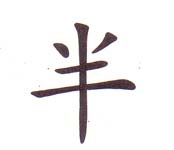 HALF can be ban. Not a whole number, it is the first concept we explore. There are many ways this number makes up a whole, most not related to English. First of all, ban often comes after the word yi meaning 'one' but not used for half-wit, half-mast, half-way, half-time, half-caste, half-board, half-hearted, half-baked, or when telling time such as in half past one. For that, the Chinese use yidian and other terms. HALF can be ban. Not a whole number, it is the first concept we explore. There are many ways this number makes up a whole, most not related to English. First of all, ban often comes after the word yi meaning 'one' but not used for half-wit, half-mast, half-way, half-time, half-caste, half-board, half-hearted, half-baked, or when telling time such as in half past one. For that, the Chinese use yidian and other terms.
 ONE is yi. There are more than sixty meanings for this initial integer, even when not counting compounds. If doing that, there are more than three thousand 'ones.' According to ancient Chinese philosophers who said "one can be divided into two" or yin and yang; and these can be divided into the five elements of wood, fire, earth, metal, and water, the Chinese believe that from these five elements, ten thousand things came about. Not so Confucius nor Laozi. They believed one can not be divided and is related to union or genesis. The Tao says 'one' is the origin of all living things, it does produce two, and two produces three, three producing all else in the universe, foods, too. ONE is yi. There are more than sixty meanings for this initial integer, even when not counting compounds. If doing that, there are more than three thousand 'ones.' According to ancient Chinese philosophers who said "one can be divided into two" or yin and yang; and these can be divided into the five elements of wood, fire, earth, metal, and water, the Chinese believe that from these five elements, ten thousand things came about. Not so Confucius nor Laozi. They believed one can not be divided and is related to union or genesis. The Tao says 'one' is the origin of all living things, it does produce two, and two produces three, three producing all else in the universe, foods, too.
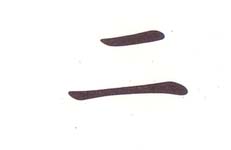 TWO is er. As with other even numbers, this number is female. In ancient times, two was earth while one was the sun. The oracle is based on two, and each of the sixty-four hexagrams in the Book of Changes consists of two superimposed trigrams. Two has three synonyms in Chinese, liang, shuang, and dui. The Chinese have a saying, that good luck comes in pairs. So at weddings, red paper is printed with the character xi, a necessary decoration there. Two xi means 'double happiness' and these two sides make a beautiful whole. However, two is not always beautiful nor happy when two describes a person. Then, it can be a derogatory statement. Furthermore, if twins are male and female, they are said to be 'ghost spouses.' A while back in Taiwan and in Qinghai, parents would kill their twins at birth if one was a boy, the other a girl. They said that keeping them made for bad tastes. TWO is er. As with other even numbers, this number is female. In ancient times, two was earth while one was the sun. The oracle is based on two, and each of the sixty-four hexagrams in the Book of Changes consists of two superimposed trigrams. Two has three synonyms in Chinese, liang, shuang, and dui. The Chinese have a saying, that good luck comes in pairs. So at weddings, red paper is printed with the character xi, a necessary decoration there. Two xi means 'double happiness' and these two sides make a beautiful whole. However, two is not always beautiful nor happy when two describes a person. Then, it can be a derogatory statement. Furthermore, if twins are male and female, they are said to be 'ghost spouses.' A while back in Taiwan and in Qinghai, parents would kill their twins at birth if one was a boy, the other a girl. They said that keeping them made for bad tastes.
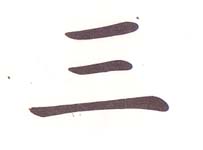 THREE is san. Taoists believe this a powerful masculine number as many Chinese traditions come in three's. The Chinese see 'three' as heaven, earth, and man, and there are three periods in early Han history, the zhong, jing, and wen. Three also means loyalty, respect, and refinement, and it corresponds to the first three dynasties, Xia, Shang, and Zhou. In The Book of Rites, man is between heaven and earth making three important items. Overall, Chinese have three wishes; these are for happiness and good fortune, long life, and riches. They have three main teachings: Confucianism, Taoism, and Buddhism, but say these teachings are one. The Buddhist Canon is divided into the three baskets, those of bamboo, pine, and plum; these trees are called 'three friends' and there is one unpopular use of three meaning 'the third eye. THREE is san. Taoists believe this a powerful masculine number as many Chinese traditions come in three's. The Chinese see 'three' as heaven, earth, and man, and there are three periods in early Han history, the zhong, jing, and wen. Three also means loyalty, respect, and refinement, and it corresponds to the first three dynasties, Xia, Shang, and Zhou. In The Book of Rites, man is between heaven and earth making three important items. Overall, Chinese have three wishes; these are for happiness and good fortune, long life, and riches. They have three main teachings: Confucianism, Taoism, and Buddhism, but say these teachings are one. The Buddhist Canon is divided into the three baskets, those of bamboo, pine, and plum; these trees are called 'three friends' and there is one unpopular use of three meaning 'the third eye.
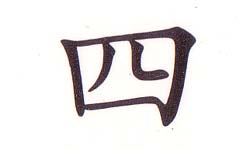 FOUR is si and the first number not written in horizontal lines. Said to be unlucky because the word 'four' sounds close to the word for 'death.' This is so unlucky that many Chinese buildings do not have a fourth floor. Chinese telephone numbers also avoid the number four. However, families with four generations living under one roof are said to be lucky; and another positive, the number four means four writings of Confucianism: The Analects, Mencius, Great Learning, and The Doctrine of the Mean. The Middle Kingdom is said to be in the middle of four seas, there are four seasons, and four journeys undertaken by Suddharta Gautama that convinced him to give up being a prince and become a Buddha. Scholars have four arts, the lute, the chessboard, books, and paintings. Chinese communism saw the feudal period as 'four olds' which were the old culture, old customs, old habits, and old ways of thinking including old ways of cooking and eating orgies such as banquets. FOUR is si and the first number not written in horizontal lines. Said to be unlucky because the word 'four' sounds close to the word for 'death.' This is so unlucky that many Chinese buildings do not have a fourth floor. Chinese telephone numbers also avoid the number four. However, families with four generations living under one roof are said to be lucky; and another positive, the number four means four writings of Confucianism: The Analects, Mencius, Great Learning, and The Doctrine of the Mean. The Middle Kingdom is said to be in the middle of four seas, there are four seasons, and four journeys undertaken by Suddharta Gautama that convinced him to give up being a prince and become a Buddha. Scholars have four arts, the lute, the chessboard, books, and paintings. Chinese communism saw the feudal period as 'four olds' which were the old culture, old customs, old habits, and old ways of thinking including old ways of cooking and eating orgies such as banquets.
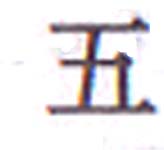 FIVE is wu, and said to be a great number as it means 'all' and refers to the visceral cavities of the small and large intestines, the bladder, stomach and gall. Five can also mean heart, liver, spleen, lungs, and kidneys. Also, there are five beautiful Chinese mountains: namely Mt. Tai in the Shandong Province, Mt. Hua in the Shanxi Province, Mt. Heng in the Hunan Province, yet another Mt. Heng, and Mt. Song, both in the Henan Province. There are Five Classics: The Book of Songs, The Classic of History, The Classic of Rites, The Book of Changes, and The Spring and Autumn Annals. There are five Chinese directions, North, South, East, West, and Center; and five Chinese aromas, five tastes, five colors, five customs, and many other 'five' things including five noxious creatures, five relationships between people, five prohibitions, etc. One dictionary lists twelve definitions for the number five; and there are more than eleven hundred compounds that use five. FIVE is wu, and said to be a great number as it means 'all' and refers to the visceral cavities of the small and large intestines, the bladder, stomach and gall. Five can also mean heart, liver, spleen, lungs, and kidneys. Also, there are five beautiful Chinese mountains: namely Mt. Tai in the Shandong Province, Mt. Hua in the Shanxi Province, Mt. Heng in the Hunan Province, yet another Mt. Heng, and Mt. Song, both in the Henan Province. There are Five Classics: The Book of Songs, The Classic of History, The Classic of Rites, The Book of Changes, and The Spring and Autumn Annals. There are five Chinese directions, North, South, East, West, and Center; and five Chinese aromas, five tastes, five colors, five customs, and many other 'five' things including five noxious creatures, five relationships between people, five prohibitions, etc. One dictionary lists twelve definitions for the number five; and there are more than eleven hundred compounds that use five.
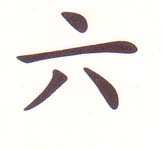 SIX is liu, with six bodily parts, six directions that include up and down. There are six great kings, six affects including anger, joy, pain, pleasure, love, and hate; and six symbols including luck, health, and family. There are six familial ties such as father and son, brothers and spouses. A person is considered cold and called 'six' because he ignores family members and refuses to use his status to grant favors to them. Six also relates to success and smooth progress while double six is very auspicious, triple six a sign of good fortune. SIX is liu, with six bodily parts, six directions that include up and down. There are six great kings, six affects including anger, joy, pain, pleasure, love, and hate; and six symbols including luck, health, and family. There are six familial ties such as father and son, brothers and spouses. A person is considered cold and called 'six' because he ignores family members and refuses to use his status to grant favors to them. Six also relates to success and smooth progress while double six is very auspicious, triple six a sign of good fortune.
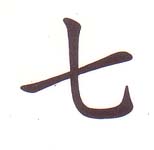 SEVEN is qi and equivalent to having butterflies in the stomach. There are seven emotions that prevent one from achieving true enlightenment that include happiness, anger, sadness, fear, love, hatred, and desire; and seven stars including the sun, moon, and five planets. The seventh day of the seventh month is 'Spinning Damsel and the Cowherd' also known as the 'Women’s Festival.' At seven months, the Chinese believe a baby girl gets her first teeth and when twice that age she begins to menstruate and can have children. At seven times seven, menopause begins and a woman can no longer have any more children. SEVEN is qi and equivalent to having butterflies in the stomach. There are seven emotions that prevent one from achieving true enlightenment that include happiness, anger, sadness, fear, love, hatred, and desire; and seven stars including the sun, moon, and five planets. The seventh day of the seventh month is 'Spinning Damsel and the Cowherd' also known as the 'Women’s Festival.' At seven months, the Chinese believe a baby girl gets her first teeth and when twice that age she begins to menstruate and can have children. At seven times seven, menopause begins and a woman can no longer have any more children.
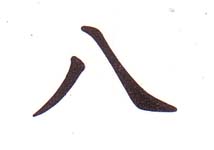 EIGHT is ba, and culinary has eight grand cuisines including Shandong, Sichuan, Gangdong, Fujian, Jiangsu, Zhejiang, Hunan, and Anhui; and there are eight Taoist trigrams. On the negative side, calling someone eight or a ba means they are a gossip and impolite. Great congee should have eight ingredients and be eaten on the eighth day of the twelfth lunar month when it is called la ba. There are eight symbols of Taoist scholars that include the pearl, musical stone, coin, books, paintings, rhinoceros horn, artemesia leaf, and rhombus. Taoist saints, sometimes called the 'eight immortals' have eight symbols. They are a fan, sword, bottle-gourd, castanets, flower basket, bamboo cane, flute, and a lotus. Buddhism also has eight symbols; theirs are the sea slug, umbrella, canopy, lotus, umbrella, fish, the endless knot, and the wheel of learning. Though eight is a yin number, it is connected to the numerology of males. At eight months a boy gets his milk teeth and at age eight loses them. At eight times eight, men are no longer able to procreate. There are eight pillars of heaven with eight mountains and eight gates, and eight winds that include the burning wind, cheering wind, roaring wind, storm wind, cool wind, wind that lasts, sharp wind, and cold wind. EIGHT is ba, and culinary has eight grand cuisines including Shandong, Sichuan, Gangdong, Fujian, Jiangsu, Zhejiang, Hunan, and Anhui; and there are eight Taoist trigrams. On the negative side, calling someone eight or a ba means they are a gossip and impolite. Great congee should have eight ingredients and be eaten on the eighth day of the twelfth lunar month when it is called la ba. There are eight symbols of Taoist scholars that include the pearl, musical stone, coin, books, paintings, rhinoceros horn, artemesia leaf, and rhombus. Taoist saints, sometimes called the 'eight immortals' have eight symbols. They are a fan, sword, bottle-gourd, castanets, flower basket, bamboo cane, flute, and a lotus. Buddhism also has eight symbols; theirs are the sea slug, umbrella, canopy, lotus, umbrella, fish, the endless knot, and the wheel of learning. Though eight is a yin number, it is connected to the numerology of males. At eight months a boy gets his milk teeth and at age eight loses them. At eight times eight, men are no longer able to procreate. There are eight pillars of heaven with eight mountains and eight gates, and eight winds that include the burning wind, cheering wind, roaring wind, storm wind, cool wind, wind that lasts, sharp wind, and cold wind.
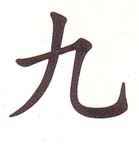 NINE is jiu, the sound of this word meaning an eternity. In ancient China, land was divided into nine territories, there were nine cauldrons and whoever owned them all was their emperor. There is a nine-dragon wall representing a royal reign, actually two of them. One is in Beijing's Behai Park, the other in the Imperial Palace which has nine thousand nine hundred and ninety-nine rooms. The ancient Book of Rites enumerates nine rites including the birth of a male child, marriage, audience, embassies, burial, sacrifice, hospitality, military traditions, and ceremonial drinking. On the ninth day of the ninth month, men should go up to the mountain for a 'double yang' feast and drink wine made of chrysanthemum flowers. The earliest Chinese encyclopedia says heaven has nine fields, the earth nine regions, the country nine mountains and nine mountains passes, and the sea nine big islands. NINE is jiu, the sound of this word meaning an eternity. In ancient China, land was divided into nine territories, there were nine cauldrons and whoever owned them all was their emperor. There is a nine-dragon wall representing a royal reign, actually two of them. One is in Beijing's Behai Park, the other in the Imperial Palace which has nine thousand nine hundred and ninety-nine rooms. The ancient Book of Rites enumerates nine rites including the birth of a male child, marriage, audience, embassies, burial, sacrifice, hospitality, military traditions, and ceremonial drinking. On the ninth day of the ninth month, men should go up to the mountain for a 'double yang' feast and drink wine made of chrysanthemum flowers. The earliest Chinese encyclopedia says heaven has nine fields, the earth nine regions, the country nine mountains and nine mountains passes, and the sea nine big islands.
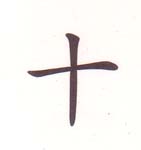 TEN is shi, written as one line crossing the other. It is the end of this ten plus one integer set. When a person wants to show the number ten they cross one index finger over the other. Two tens are a perfect state; one nine and one ten is being confident, and ten parts are a high level of achievement. Ten heavenly stems are mentioned in the oldest of texts, the number ten said to have other meanings, most unclear. Ten does denote completeness in many things, and the number ten when counting is a perfect place to end; and so we do. TEN is shi, written as one line crossing the other. It is the end of this ten plus one integer set. When a person wants to show the number ten they cross one index finger over the other. Two tens are a perfect state; one nine and one ten is being confident, and ten parts are a high level of achievement. Ten heavenly stems are mentioned in the oldest of texts, the number ten said to have other meanings, most unclear. Ten does denote completeness in many things, and the number ten when counting is a perfect place to end; and so we do.
|

 HALF can be ban. Not a whole number, it is the first concept we explore. There are many ways this number makes up a whole, most not related to English. First of all, ban often comes after the word yi meaning 'one' but not used for half-wit, half-mast, half-way, half-time, half-caste, half-board, half-hearted, half-baked, or when telling time such as in half past one. For that, the Chinese use yidian and other terms.
HALF can be ban. Not a whole number, it is the first concept we explore. There are many ways this number makes up a whole, most not related to English. First of all, ban often comes after the word yi meaning 'one' but not used for half-wit, half-mast, half-way, half-time, half-caste, half-board, half-hearted, half-baked, or when telling time such as in half past one. For that, the Chinese use yidian and other terms. ONE is yi. There are more than sixty meanings for this initial integer, even when not counting compounds. If doing that, there are more than three thousand 'ones.' According to ancient Chinese philosophers who said "one can be divided into two" or yin and yang; and these can be divided into the five elements of wood, fire, earth, metal, and water, the Chinese believe that from these five elements, ten thousand things came about. Not so Confucius nor Laozi. They believed one can not be divided and is related to union or genesis. The Tao says 'one' is the origin of all living things, it does produce two, and two produces three, three producing all else in the universe, foods, too.
ONE is yi. There are more than sixty meanings for this initial integer, even when not counting compounds. If doing that, there are more than three thousand 'ones.' According to ancient Chinese philosophers who said "one can be divided into two" or yin and yang; and these can be divided into the five elements of wood, fire, earth, metal, and water, the Chinese believe that from these five elements, ten thousand things came about. Not so Confucius nor Laozi. They believed one can not be divided and is related to union or genesis. The Tao says 'one' is the origin of all living things, it does produce two, and two produces three, three producing all else in the universe, foods, too.  TWO is er. As with other even numbers, this number is female. In ancient times, two was earth while one was the sun. The oracle is based on two, and each of the sixty-four hexagrams in the Book of Changes consists of two superimposed trigrams. Two has three synonyms in Chinese, liang, shuang, and dui. The Chinese have a saying, that good luck comes in pairs. So at weddings, red paper is printed with the character xi, a necessary decoration there. Two xi means 'double happiness' and these two sides make a beautiful whole. However, two is not always beautiful nor happy when two describes a person. Then, it can be a derogatory statement. Furthermore, if twins are male and female, they are said to be 'ghost spouses.' A while back in Taiwan and in Qinghai, parents would kill their twins at birth if one was a boy, the other a girl. They said that keeping them made for bad tastes.
TWO is er. As with other even numbers, this number is female. In ancient times, two was earth while one was the sun. The oracle is based on two, and each of the sixty-four hexagrams in the Book of Changes consists of two superimposed trigrams. Two has three synonyms in Chinese, liang, shuang, and dui. The Chinese have a saying, that good luck comes in pairs. So at weddings, red paper is printed with the character xi, a necessary decoration there. Two xi means 'double happiness' and these two sides make a beautiful whole. However, two is not always beautiful nor happy when two describes a person. Then, it can be a derogatory statement. Furthermore, if twins are male and female, they are said to be 'ghost spouses.' A while back in Taiwan and in Qinghai, parents would kill their twins at birth if one was a boy, the other a girl. They said that keeping them made for bad tastes. THREE is san. Taoists believe this a powerful masculine number as many Chinese traditions come in three's. The Chinese see 'three' as heaven, earth, and man, and there are three periods in early Han history, the zhong, jing, and wen. Three also means loyalty, respect, and refinement, and it corresponds to the first three dynasties, Xia, Shang, and Zhou. In The Book of Rites, man is between heaven and earth making three important items. Overall, Chinese have three wishes; these are for happiness and good fortune, long life, and riches. They have three main teachings: Confucianism, Taoism, and Buddhism, but say these teachings are one. The Buddhist Canon is divided into the three baskets, those of bamboo, pine, and plum; these trees are called 'three friends' and there is one unpopular use of three meaning 'the third eye.
THREE is san. Taoists believe this a powerful masculine number as many Chinese traditions come in three's. The Chinese see 'three' as heaven, earth, and man, and there are three periods in early Han history, the zhong, jing, and wen. Three also means loyalty, respect, and refinement, and it corresponds to the first three dynasties, Xia, Shang, and Zhou. In The Book of Rites, man is between heaven and earth making three important items. Overall, Chinese have three wishes; these are for happiness and good fortune, long life, and riches. They have three main teachings: Confucianism, Taoism, and Buddhism, but say these teachings are one. The Buddhist Canon is divided into the three baskets, those of bamboo, pine, and plum; these trees are called 'three friends' and there is one unpopular use of three meaning 'the third eye.  FOUR is si and the first number not written in horizontal lines. Said to be unlucky because the word 'four' sounds close to the word for 'death.' This is so unlucky that many Chinese buildings do not have a fourth floor. Chinese telephone numbers also avoid the number four. However, families with four generations living under one roof are said to be lucky; and another positive, the number four means four writings of Confucianism: The Analects, Mencius, Great Learning, and The Doctrine of the Mean. The Middle Kingdom is said to be in the middle of four seas, there are four seasons, and four journeys undertaken by Suddharta Gautama that convinced him to give up being a prince and become a Buddha. Scholars have four arts, the lute, the chessboard, books, and paintings. Chinese communism saw the feudal period as 'four olds' which were the old culture, old customs, old habits, and old ways of thinking including old ways of cooking and eating orgies such as banquets.
FOUR is si and the first number not written in horizontal lines. Said to be unlucky because the word 'four' sounds close to the word for 'death.' This is so unlucky that many Chinese buildings do not have a fourth floor. Chinese telephone numbers also avoid the number four. However, families with four generations living under one roof are said to be lucky; and another positive, the number four means four writings of Confucianism: The Analects, Mencius, Great Learning, and The Doctrine of the Mean. The Middle Kingdom is said to be in the middle of four seas, there are four seasons, and four journeys undertaken by Suddharta Gautama that convinced him to give up being a prince and become a Buddha. Scholars have four arts, the lute, the chessboard, books, and paintings. Chinese communism saw the feudal period as 'four olds' which were the old culture, old customs, old habits, and old ways of thinking including old ways of cooking and eating orgies such as banquets.  FIVE is wu, and said to be a great number as it means 'all' and refers to the visceral cavities of the small and large intestines, the bladder, stomach and gall. Five can also mean heart, liver, spleen, lungs, and kidneys. Also, there are five beautiful Chinese mountains: namely Mt. Tai in the Shandong Province, Mt. Hua in the Shanxi Province, Mt. Heng in the Hunan Province, yet another Mt. Heng, and Mt. Song, both in the Henan Province. There are Five Classics: The Book of Songs, The Classic of History, The Classic of Rites, The Book of Changes, and The Spring and Autumn Annals. There are five Chinese directions, North, South, East, West, and Center; and five Chinese aromas, five tastes, five colors, five customs, and many other 'five' things including five noxious creatures, five relationships between people, five prohibitions, etc. One dictionary lists twelve definitions for the number five; and there are more than eleven hundred compounds that use five.
FIVE is wu, and said to be a great number as it means 'all' and refers to the visceral cavities of the small and large intestines, the bladder, stomach and gall. Five can also mean heart, liver, spleen, lungs, and kidneys. Also, there are five beautiful Chinese mountains: namely Mt. Tai in the Shandong Province, Mt. Hua in the Shanxi Province, Mt. Heng in the Hunan Province, yet another Mt. Heng, and Mt. Song, both in the Henan Province. There are Five Classics: The Book of Songs, The Classic of History, The Classic of Rites, The Book of Changes, and The Spring and Autumn Annals. There are five Chinese directions, North, South, East, West, and Center; and five Chinese aromas, five tastes, five colors, five customs, and many other 'five' things including five noxious creatures, five relationships between people, five prohibitions, etc. One dictionary lists twelve definitions for the number five; and there are more than eleven hundred compounds that use five. SIX is liu, with six bodily parts, six directions that include up and down. There are six great kings, six affects including anger, joy, pain, pleasure, love, and hate; and six symbols including luck, health, and family. There are six familial ties such as father and son, brothers and spouses. A person is considered cold and called 'six' because he ignores family members and refuses to use his status to grant favors to them. Six also relates to success and smooth progress while double six is very auspicious, triple six a sign of good fortune.
SIX is liu, with six bodily parts, six directions that include up and down. There are six great kings, six affects including anger, joy, pain, pleasure, love, and hate; and six symbols including luck, health, and family. There are six familial ties such as father and son, brothers and spouses. A person is considered cold and called 'six' because he ignores family members and refuses to use his status to grant favors to them. Six also relates to success and smooth progress while double six is very auspicious, triple six a sign of good fortune.  SEVEN is qi and equivalent to having butterflies in the stomach. There are seven emotions that prevent one from achieving true enlightenment that include happiness, anger, sadness, fear, love, hatred, and desire; and seven stars including the sun, moon, and five planets. The seventh day of the seventh month is 'Spinning Damsel and the Cowherd' also known as the 'Women’s Festival.' At seven months, the Chinese believe a baby girl gets her first teeth and when twice that age she begins to menstruate and can have children. At seven times seven, menopause begins and a woman can no longer have any more children.
SEVEN is qi and equivalent to having butterflies in the stomach. There are seven emotions that prevent one from achieving true enlightenment that include happiness, anger, sadness, fear, love, hatred, and desire; and seven stars including the sun, moon, and five planets. The seventh day of the seventh month is 'Spinning Damsel and the Cowherd' also known as the 'Women’s Festival.' At seven months, the Chinese believe a baby girl gets her first teeth and when twice that age she begins to menstruate and can have children. At seven times seven, menopause begins and a woman can no longer have any more children.  EIGHT is ba, and culinary has eight grand cuisines including Shandong, Sichuan, Gangdong, Fujian, Jiangsu, Zhejiang, Hunan, and Anhui; and there are eight Taoist trigrams. On the negative side, calling someone eight or a ba means they are a gossip and impolite. Great congee should have eight ingredients and be eaten on the eighth day of the twelfth lunar month when it is called la ba. There are eight symbols of Taoist scholars that include the pearl, musical stone, coin, books, paintings, rhinoceros horn, artemesia leaf, and rhombus. Taoist saints, sometimes called the 'eight immortals' have eight symbols. They are a fan, sword, bottle-gourd, castanets, flower basket, bamboo cane, flute, and a lotus. Buddhism also has eight symbols; theirs are the sea slug, umbrella, canopy, lotus, umbrella, fish, the endless knot, and the wheel of learning. Though eight is a yin number, it is connected to the numerology of males. At eight months a boy gets his milk teeth and at age eight loses them. At eight times eight, men are no longer able to procreate. There are eight pillars of heaven with eight mountains and eight gates, and eight winds that include the burning wind, cheering wind, roaring wind, storm wind, cool wind, wind that lasts, sharp wind, and cold wind.
EIGHT is ba, and culinary has eight grand cuisines including Shandong, Sichuan, Gangdong, Fujian, Jiangsu, Zhejiang, Hunan, and Anhui; and there are eight Taoist trigrams. On the negative side, calling someone eight or a ba means they are a gossip and impolite. Great congee should have eight ingredients and be eaten on the eighth day of the twelfth lunar month when it is called la ba. There are eight symbols of Taoist scholars that include the pearl, musical stone, coin, books, paintings, rhinoceros horn, artemesia leaf, and rhombus. Taoist saints, sometimes called the 'eight immortals' have eight symbols. They are a fan, sword, bottle-gourd, castanets, flower basket, bamboo cane, flute, and a lotus. Buddhism also has eight symbols; theirs are the sea slug, umbrella, canopy, lotus, umbrella, fish, the endless knot, and the wheel of learning. Though eight is a yin number, it is connected to the numerology of males. At eight months a boy gets his milk teeth and at age eight loses them. At eight times eight, men are no longer able to procreate. There are eight pillars of heaven with eight mountains and eight gates, and eight winds that include the burning wind, cheering wind, roaring wind, storm wind, cool wind, wind that lasts, sharp wind, and cold wind.
 NINE is jiu, the sound of this word meaning an eternity. In ancient China, land was divided into nine territories, there were nine cauldrons and whoever owned them all was their emperor. There is a nine-dragon wall representing a royal reign, actually two of them. One is in Beijing's Behai Park, the other in the Imperial Palace which has nine thousand nine hundred and ninety-nine rooms. The ancient Book of Rites enumerates nine rites including the birth of a male child, marriage, audience, embassies, burial, sacrifice, hospitality, military traditions, and ceremonial drinking. On the ninth day of the ninth month, men should go up to the mountain for a 'double yang' feast and drink wine made of chrysanthemum flowers. The earliest Chinese encyclopedia says heaven has nine fields, the earth nine regions, the country nine mountains and nine mountains passes, and the sea nine big islands.
NINE is jiu, the sound of this word meaning an eternity. In ancient China, land was divided into nine territories, there were nine cauldrons and whoever owned them all was their emperor. There is a nine-dragon wall representing a royal reign, actually two of them. One is in Beijing's Behai Park, the other in the Imperial Palace which has nine thousand nine hundred and ninety-nine rooms. The ancient Book of Rites enumerates nine rites including the birth of a male child, marriage, audience, embassies, burial, sacrifice, hospitality, military traditions, and ceremonial drinking. On the ninth day of the ninth month, men should go up to the mountain for a 'double yang' feast and drink wine made of chrysanthemum flowers. The earliest Chinese encyclopedia says heaven has nine fields, the earth nine regions, the country nine mountains and nine mountains passes, and the sea nine big islands. TEN is shi, written as one line crossing the other. It is the end of this ten plus one integer set. When a person wants to show the number ten they cross one index finger over the other. Two tens are a perfect state; one nine and one ten is being confident, and ten parts are a high level of achievement. Ten heavenly stems are mentioned in the oldest of texts, the number ten said to have other meanings, most unclear. Ten does denote completeness in many things, and the number ten when counting is a perfect place to end; and so we do.
TEN is shi, written as one line crossing the other. It is the end of this ten plus one integer set. When a person wants to show the number ten they cross one index finger over the other. Two tens are a perfect state; one nine and one ten is being confident, and ten parts are a high level of achievement. Ten heavenly stems are mentioned in the oldest of texts, the number ten said to have other meanings, most unclear. Ten does denote completeness in many things, and the number ten when counting is a perfect place to end; and so we do.